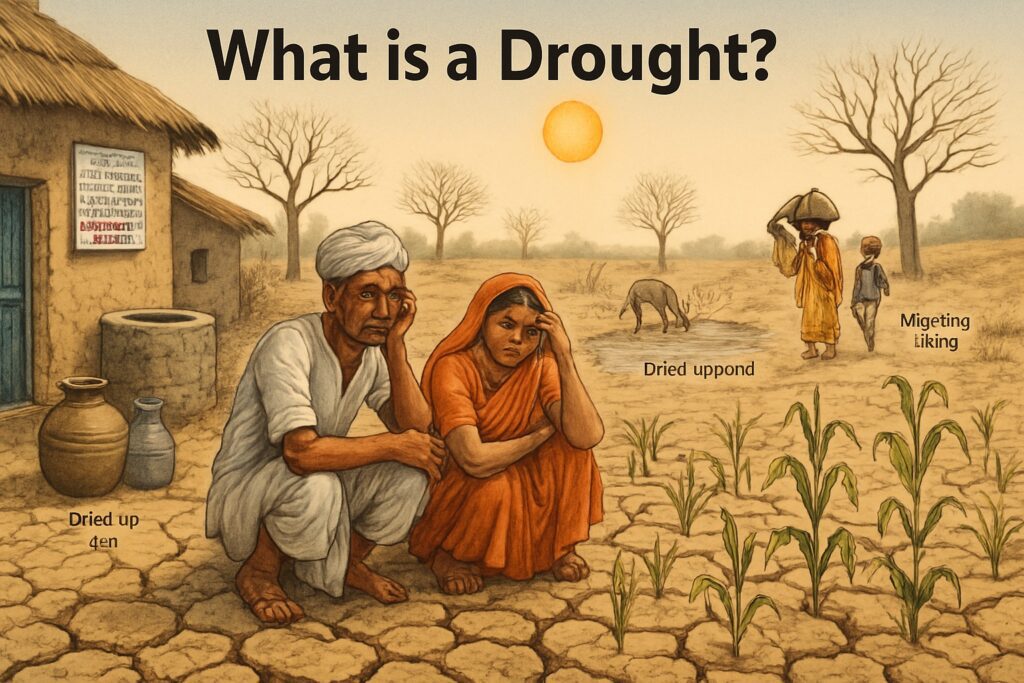A drought is a prolonged period of deficient rainfall that leads to a severe water shortage, affecting agriculture, drinking water supplies, and livelihoods. India, being an agrarian economy and heavily dependent on monsoon rains, is particularly vulnerable to droughts. Droughts can lead to crop failure, famine, migration, and economic distress, especially in rural areas.

Table of Contents
What is a Drought?
A drought is defined as an extended period of little or no rainfall in a region, resulting in a water shortage that impacts people, animals, and the environment. It is a slow-onset disaster, meaning it develops gradually over time.
Types of Drought
- Meteorological Drought: When rainfall is significantly below average.
- Agricultural Drought: When soil moisture is insufficient for crop growth.
- Hydrological Drought: When rivers, reservoirs, and groundwater levels fall below normal.
- Socio-Economic Drought: When the drought impacts economy and human life.
Causes of Drought in India
- Monsoon Failure: Delayed, weak, or erratic rainfall during the southwest monsoon season (June–September).
- El Niño Effect: Abnormal warming of the Pacific Ocean that disrupts monsoon patterns.
- Deforestation: Reduces rainfall and soil moisture retention.
- Overuse of Groundwater: Excessive irrigation and pumping lower water tables.
- Climate Change: Increased temperatures and unpredictable rainfall patterns.
Drought-Prone Areas in India
Some regions frequently face drought due to low rainfall and poor water management:
- Rajasthan – Particularly in western desert areas.
- Maharashtra – Especially the Marathwada and Vidarbha regions.
- Karnataka – Northern districts face regular droughts.
- Andhra Pradesh & Telangana
- Gujarat
- Tamil Nadu
Major Droughts in India (Historical Events)
| Year | Region | Impact |
|---|---|---|
| 1965–1967 | Nationwide | Severe famine, food shortages, thousands of deaths |
| 1987 | Northern & Central India | Worst drought of the 20th century |
| 2002 | All-India | Rainfall was 19% below average |
| 2015–2016 | Maharashtra, Karnataka | Crop failure, water trains sent to Latur |
Effects of Drought
- Crop Failure and food shortages
- Water scarcity for drinking, irrigation, and livestock
- Loss of Livelihood for farmers and rural laborers
- Famine and Malnutrition
- Migration from rural to urban areas
- Desertification and land degradation
Drought Management and Government Response
- Early Warning Systems: Rainfall prediction by IMD and monitoring by Central Drought Relief Commission.
- Water Conservation Projects:
- Rainwater harvesting
- Watershed development
- Check dams and tanks
- Relief Measures:
- Crop insurance schemes (e.g., PMFBY)
- Employment under MGNREGA
- Supply of drinking water through tankers and trains
- Drought-Resistant Crops: Promotion of millets and hardy crops in dry regions.
Long-Term Solutions
- Afforestation: Helps retain moisture and increase rainfall.
- Efficient Irrigation: Drip and sprinkler irrigation systems.
- Groundwater Recharge: Using percolation pits and ponds.
- Crop Diversification: Reducing dependence on water-intensive crops like sugarcane and paddy.
Conclusion
Droughts remain a major environmental and economic challenge for India. With growing population pressure and climate change, their frequency and intensity are increasing. Sustainable water management, timely government response, and community participation are essential to reduce the impact of droughts and build resilience in vulnerable regions.
Read: Geography Notes